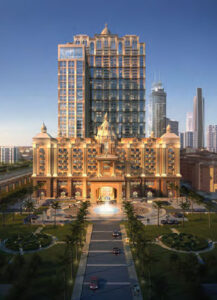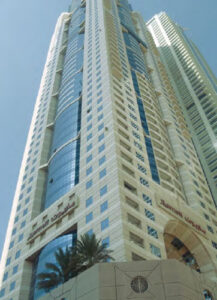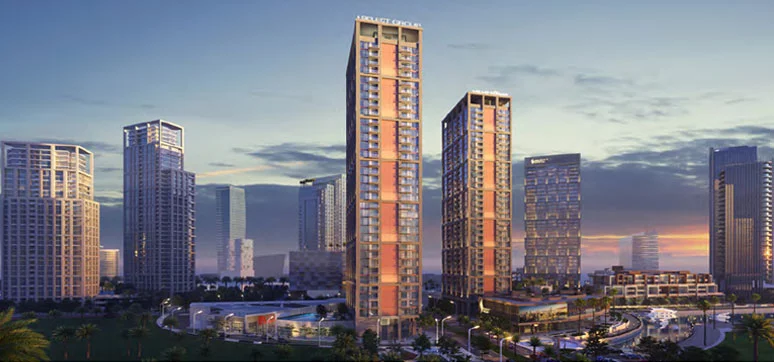Tell us about your practice and design approach?

Khatib & Alami is a multidisciplinary design firm with a strong track record across the Middle East and Africa region. As well as architects, we employ experts from across the built environment spectrum, including planners, engineers, environmental specialists, project managers, and technologists. This has a strong influence on our design approach because it gives us an opportunity to work in a practical and holistic way with colleagues from across the business.
What inspired you to become an architect?
My love of architecture started when I was a child. I was always fascinated by buildings design, wondering about adding some elements to the buildings as well as the materials used in the construction of buildings. This interest grew into thinking about how we could make buildings better, especially for the people who use them.
I presume you connect a lot of art and architecture in your projects.
There is a strong connection between artistic styles and architecture. We are led by our discussions with clients, as well as local authority requirements. Most clients will provide us with an idea about the building style they are looking for to be reflected in the design, such as modern classic, Art Deco, modern or postmodern styles.

In the end, we provide different design options with different design ideas and styles reflecting what the client wants, and then we develop the preferred option by the client. As architects, we have to satisfy the client and the end-users. We always need to find solutions to meet the design intent, the durability, and the construction program.
transmittance glass to bring more natural light to the office space, and consider energy savings and thermal comfort by using double glass with low-emissivity coating. Other important factors were the acoustic performance of the glass, as well as its safety function.
By comparison, in the residential floors, the considerations for glass selection were different with respect to various criteria. For instance, the locations for glass vision panels were selected to fit the proposed furniture layout, while for visual comfort we selected large windows with good light transmittance and low indoor light reflectance, which helps to avoid the mirror-like effect at night.
Another interesting challenge was Al Habtoor City, a high-rise hospitality project in Dubai that has a classical, Art Deco theme. It is a huge project for which we were working on the design parallel to the construction. To meet the construction program, we used different systems for façade construction and One of the boldest projects I have worked on in the UAE was Bay Square, a mixed-use project in Dubai with about 550,000 m2 BUA.

The client was looking for a contemporary modern design that maximized the levels of transparency in the façade. The challenge was to create consistency in the façade with the different functions in the same buildings (Retail, Offices, and Residential).
We achieved that with the careful selection and sizing of high-performance glass taking into consideration the function in addition to the need to control the heat gain while bringing enough natural light for the internal spaces.
A key aim was to create a thermal comfort zone for the office floors, because this has a direct impact on users, enabling them to be more efficient and productive. We therefore carefully selected the glass location and the type of glass. Different criteria were considered such as maximizing the amount of vision glass, choosing high light different materials to suit the proposed systems, taking into consideration the design style which was another challenge to use the proper materials fit for the design style.
Could you please tell us about the latest façade and cladding technologies and materials available in the UAE market and those you used in your project?

New technologies and systems tend to reach the UAE quickly, and this is reflected in the materials used in building envelopes.
It is great working in the UAE market because clients here tend to be quite open to new ideas and ways of doing things, but even so, there is always some hesitation about using materials for the first time in the region, even if they are proven elsewhere.
This is understandable, of course, because anything new represents a risk, and there is no denying that the environment in this region is much harsher on outdoor materials than most other parts of the world. Clients, therefore, tend to want to see mockups, and to test them as much as possible.
The choice of material depends on the function, location, client acceptance, and, of course, budget while maintaining the look and feel of the design intent. We are currently working on various projects in the region and North Africa which include a lot of man-made stone, treated wood, and different types of render cladding systems.
They are beautiful products to work with because they give a sense of being natural and user-friendly, and they meet the design intent and the project function. Some of these materials need maintenance. Where possible, therefore, in the touchable area we focus on using low maintenance materials which meet the budget and are relatively heavy-duty and durable, while in other places away from people, the materials still need to be durable and low maintenance, but they don’t need to withstand the same impacts so we can usually find something with a similar look at a lesser cost.
What are the key factors to consider while designing and installing fenestration?
I always consider the following factors in the selection of fenestration, glass, and the system:

• The buildings function
• The required light amount
• Physical performance
• Energy characteristics
• Thermal performance
• Acoustic performance
• Safety and security
• Fire performance
• Sustainability requirements
• Constructibility
• Construction program
• Design to cost
For example, residential or hospitality projects need to avoid the potential for high indoor reflection which will be unpleasant at night due to the mirror-like effect. This is less important for office buildings since they will be used primarily in the daytime while having a high light transmittance is a very important factor for glass in office spaces. You also need to think about installation. We want as much work as possible to be done in the factory so that when the product arrives on site, it only needs to be fitted. This reduces risk while improving the quality and speed of construction.
Could you please brief me on the technological benefits of the well-managed façades?
There is now an increasing focus on façades due to the growing importance given to exterior walls, in the context of energy consumption and options of producing clean power. Having a high-performance façade leads to reduced building energy consumption, and improves comfort for a building’s users. In addition, façades can use technologies such as advertising screens, which will increase the income generation potential of the buildings for the owner.
What are your views on the future façade and fenestration technologies as well as materials?

The façade forms a separating and filtering layer between the inside and outside. The key considerations are always environmental friendliness (C2C), durability, and performance. I am currently involved with three projects which are aiming for LEED Platinum standard, but even for other projects we always use LEED measures as the benchmark, even if not required by the client.
I always keep in touch with industry trends. Inevitably, for new materials to be more attractive they need to be more durable with a better thermal performance. Other considerations are maintenance, speed of construction, manufacturing process, impact on the environment, and weight and transparency. Some of the most interesting advances in the future are likely to relate to carbon fiber composites, which can be incredibly light, strong, and flexible. I am also excited by technologies such as transparent photovoltaic panels which can generate energy for a building. Imagine the impact that this could eventually have.
How do you go about choosing the material of façade and cladding?
The façade is the building face and is the first line of defense for buildings; building envelopes offer protection from the weather and keep the building secure. The more divergent the outdoor climate and indoor climatic requirements are, the bigger the technical efforts required to meet the requirements of people inside the space when considering issues such as air temperature; relative humidity; the air temperature in the zone adjacent to the façade; air flows reaching the body; and acoustic levels.
Then of course you have the issues of aesthetic design, performance, building constructability, budget and local authority regulations, the site location, and how it interacts with its surroundings. When we bring these factors together, we are able to narrow down the options available, and this informs our recommendations to the client.
What is your advice for young and upcoming architects?
I always tell emerging architects to read, keep learning, be inquisitive and build their understanding. They should pay attention to what others with more experience are doing, but don’t be afraid to bring fresh ideas and challenge the accepted wisdom. Preparation and research are always essential, and that never stops regardless of age, stature, or experience.














